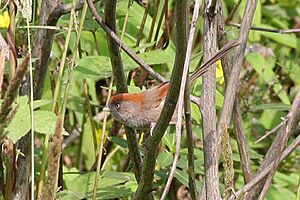Ashy-throated parrotbill facts for kids
Quick facts for kids Ashy-throated parrotbill |
|
|---|---|
 |
|
| Conservation status | |
| Scientific classification | |
| Genus: |
Suthora
|
| Species: |
alphonsiana
|
 |
|
| Synonyms | |
|
Sinosuthora alphonsiana J. Verreaux, 1870 |
|
The ashy-throated parrotbill (Suthora alphonsiana) is a special type of bird called a parrotbill. You might hear it called "Alphonse's crow-tit" in older books. Even though it looks a bit like a tit, it's not actually part of the tit family.
This bird lives in parts of China and northern Vietnam. It might also have made a new home in one area of Italy.
What Does It Look Like?
The ashy-throated parrotbill is a medium-sized bird. It has a tawny (brownish-orange) color. Like other parrotbills, it has a large, strong beak. The bird's scientific name, alphonsiana, honors a French bird expert named Alphonse Milne-Edwards.
Scientists used to think parrotbills belonged to other bird families. These included the typical warblers or the Old World babblers. Now, most scientists agree that parrotbills belong to their own special family, called Paradoxornithidae.
A New Home in Italy?
A group of parrotbills was first seen in northern Italy in 1995. This was at a place called the Riserva naturale Palude Brabbia (which means Brabbia Swamp Nature Reserve). This swamp is located between two lakes, Lago di Varese and Lago di Comabbio.
In 1998, scientists caught and photographed 21 of these birds. They thought they were ashy-throated parrotbills. However, it's still not completely clear if they are this exact species. They could be a close relative, the vinous-throated parrotbill (S. webbiana). It's even possible they are a mix of both species.
Scientists believe these birds escaped from a nearby bird trader. By 1999, there were at least a hundred parrotbills in the swamp. They were also seen in other places around Lago di Varese. By the early 2000s, these birds had settled in and were raising their young. This is the only group of parrotbills living freely in Europe.
How It Lives
Unlike some of their relatives, these birds are small omnivores. This means they eat both plants and small animals. They are very good at living in reed beds. In their native lands, they live in bamboo forests and areas with tall grasses.
The parrotbills in Italy's Brabbia Swamp live in beds of common reed. They also live in drier areas with plants like meadowsweet and grey willow.
They eat arthropods (like insects), seeds, and plant buds. In winter, the Italian birds seem to eat insects that hide inside reed stalks. Their eggs are small for a parrotbill. They are whitish or light blue and do not have spots.
This bird needs wetlands to survive. If these areas are drained, the birds will disappear. However, they live in a very large area. Much of their habitat is far away from people. Because of this, the IUCN (a group that tracks animal populations) says the ashy-throated parrotbill is a species of Least Concern. This means it is not currently in danger.



